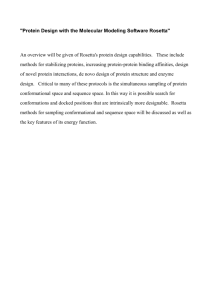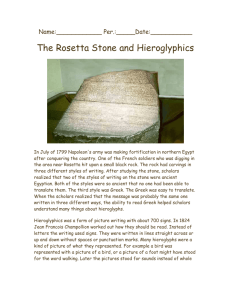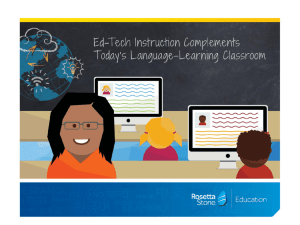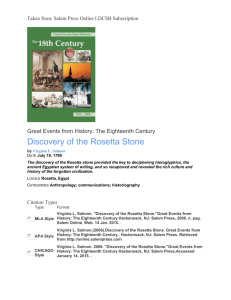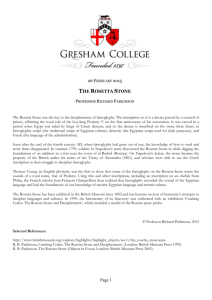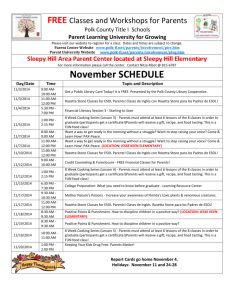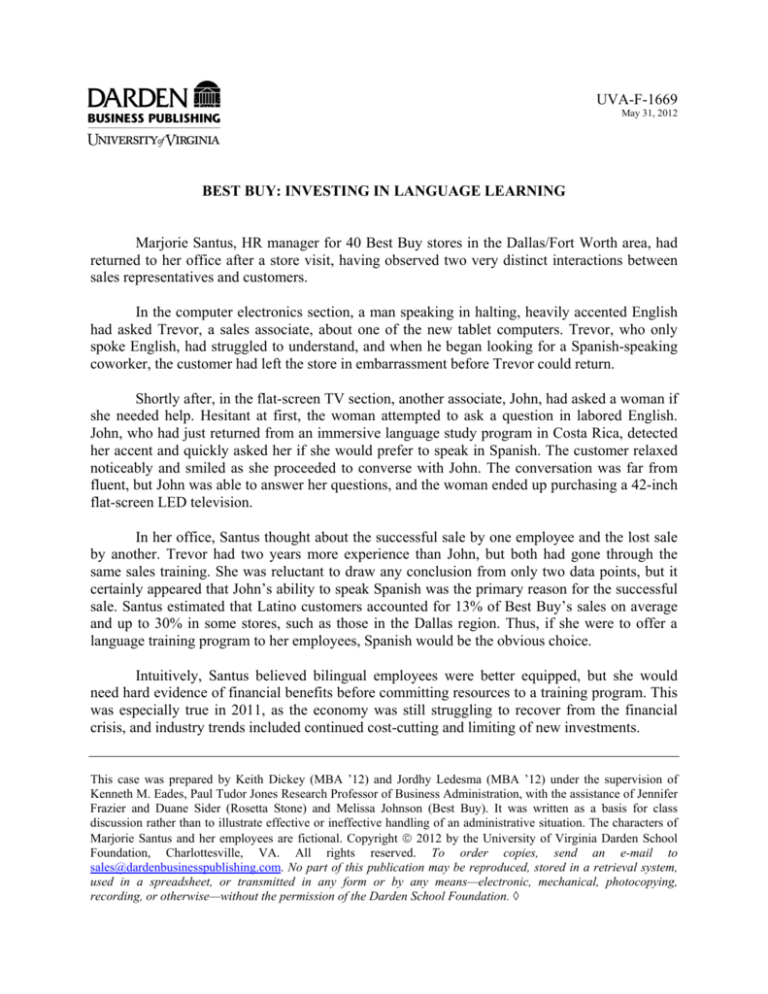
UVA-F-1669
May 31, 2012
BEST BUY: INVESTING IN LANGUAGE LEARNING
Marjorie Santus, HR manager for 40 Best Buy stores in the Dallas/Fort Worth area, had
returned to her office after a store visit, having observed two very distinct interactions between
sales representatives and customers.
In the computer electronics section, a man speaking in halting, heavily accented English
had asked Trevor, a sales associate, about one of the new tablet computers. Trevor, who only
spoke English, had struggled to understand, and when he began looking for a Spanish-speaking
coworker, the customer had left the store in embarrassment before Trevor could return.
Shortly after, in the flat-screen TV section, another associate, John, had asked a woman if
she needed help. Hesitant at first, the woman attempted to ask a question in labored English.
John, who had just returned from an immersive language study program in Costa Rica, detected
her accent and quickly asked her if she would prefer to speak in Spanish. The customer relaxed
noticeably and smiled as she proceeded to converse with John. The conversation was far from
fluent, but John was able to answer her questions, and the woman ended up purchasing a 42-inch
flat-screen LED television.
In her office, Santus thought about the successful sale by one employee and the lost sale
by another. Trevor had two years more experience than John, but both had gone through the
same sales training. She was reluctant to draw any conclusion from only two data points, but it
certainly appeared that John’s ability to speak Spanish was the primary reason for the successful
sale. Santus estimated that Latino customers accounted for 13% of Best Buy’s sales on average
and up to 30% in some stores, such as those in the Dallas region. Thus, if she were to offer a
language training program to her employees, Spanish would be the obvious choice.
Intuitively, Santus believed bilingual employees were better equipped, but she would
need hard evidence of financial benefits before committing resources to a training program. This
was especially true in 2011, as the economy was still struggling to recover from the financial
crisis, and industry trends included continued cost-cutting and limiting of new investments.
This case was prepared by Keith Dickey (MBA ’12) and Jordhy Ledesma (MBA ’12) under the supervision of
Kenneth M. Eades, Paul Tudor Jones Research Professor of Business Administration, with the assistance of Jennifer
Frazier and Duane Sider (Rosetta Stone) and Melissa Johnson (Best Buy). It was written as a basis for class
discussion rather than to illustrate effective or ineffective handling of an administrative situation. The characters of
Marjorie Santus and her employees are fictional. Copyright 2012 by the University of Virginia Darden School
Foundation, Charlottesville, VA. All rights reserved. To order copies, send an e-mail to
sales@dardenbusinesspublishing.com. No part of this publication may be reproduced, stored in a retrieval system,
used in a spreadsheet, or transmitted in any form or by any means—electronic, mechanical, photocopying,
recording, or otherwise—without the permission of the Darden School Foundation. ◊
-2-
UVA-F-1669
When it came to language learning, the first thing to come to Santus’s mind was Rosetta
Stone. Any business traveler would have been acquainted with the bright yellow Rosetta Stone
kiosks in airports. More important, Santus had many friends who had learned Spanish using the
Rosetta Stone program. She thought to herself:
At least I can’t go wrong starting with a recognized product like Rosetta Stone.
The question is whether I can justify the price for such a premium product within
our corporate culture, which is quantitatively driven. In fact, if I can’t quote some
sort of return on investment for language learning, the idea simply won’t compete
with proposals that have clear financial gains associated with them. I know that
bilingual employees are better, I just need to translate “better” into dollars, and
I’m not quite sure how to do that.
Best Buy
Best Buy was a leading electronics retailer in the United States, with over 1,000 stores
and revenues totaling $35 billion in 2010 (see Exhibits 1, 2, and 3 for Best Buy financial
statements and summary financials of comparables). In recent years, Best Buy had implemented
a new business model called customer-centricity that focused on the customer experience from
end to end. This new model encouraged store managers to increase employee training to ensure
improved customer satisfaction (measured by decrease in number of complaints and increase in
repeat sales). Customer satisfaction was believed to lead to higher revenue spend per customer.
The company had long shown an ability to grow, change, and evolve with the times. In
1966, as stereophonic recordings on vinyl records and FM radio broadcasting grew in popularity,
Richard Schulze and a business partner opened an audio component store, Sound of Music, in St.
Paul, Minnesota. In its first year, the store had gross sales of $173,000. Encouraged, the partners
bought two more companies in 1967, opened two more Sound of Music stores, and then went
public in 1969. By 1970, revenues had reached $1 million. In 1974, the stores expanded their
offerings to include videotape and videodisc products and equipment. After a tornado hit the
Roseville, Minnesota, store in 1981, Schulze held a Tornado Sale, with low prices in a no-frills
retail environment; it was the introduction of what would one day become the foundation of the
company’s business model.
In the early 1980s, the company expanded its product lines to include more technology
products, opened its first superstore, and changed its name to Best Buy. In 1985, Best Buy raised
$8 million in a stock offering to fund the opening of three more superstores. A 12-store
expansion was financed by a second stock offering of $33.6 million. Four year later, Best Buy
changed its format once again, introducing the yellow-tag logo and offering customers pressurefree shopping in a warehouse-style store staffed by noncommissioned sales personnel.
During the decades of the 1990s and 2000s, Best Buy experienced unprecedented growth.
The company began by expanding from Minnesota into Texas and Illinois, followed by a series
-3-
UVA-F-1669
of concept acquisitions. In 2002, Best Buy bought Future Shop, Ltd., and the Geek Squad, which
was its first foray into the home and commercial service business. In 2006 and 2007, the
company acquired a 75% interest in Jiangsu Five Star Appliance Co., a Chinese retailer, and
Pacific Sales Kitchen and Bath Centers, which operated 14 showrooms catering to customers
interested in home remodeling. Along with the acquisitions, Best Buy revamped its business
strategy by adopting the customer-centricity business model, which put a renewed emphasis on
the customer experience and customer satisfaction.
Rosetta Stone
In the 1980s, Allen Stoltzfus, an economics professor, real estate agent, and history buff,
was frustrated with his slow progress in mastering the Russian language. He was enrolled in a
conventional classroom Russian course but found it much less effective than his experience
learning German while living in Germany and being part of that culture. This led to Stoltzfus’s
development of a different approach to learning a language through the use of a computer. The
premise was to use a more natural language learning method that simulated the way people learn
their native language—with pictures and sounds in context. Rather than learn the language by
translating one language to another, Stoltzfus’s approach was to use computer technology to
encourage the learner to think in the target language from the beginning.
Stoltzfus enlisted his brother-in-law, John Fairfield, a computer scientist, to help him
explore how a computer could facilitate language learning. These efforts eventually led to the
founding of Fairfield Language Technologies in Harrisonburg, Virginia. The emergence of CDROM technology in the 1990s made the technology accessible to anyone with a personal
computer; the company released its first language training software product to the retail market
in 1993 under the name Rosetta Stone.
By offering images, text, and spoken word together, the software presented vocabulary
and grammatical functions intuitively, much in the way children learn their first language. The
firm called its method dynamic immersion—“dynamic” because of the engaging interactive
learning process afforded by digital technology and “immersion” because of the exclusive use of
the target language. The company pointed to a research study wherein students who completed
55 hours of language study with the Rosetta Stone Spanish program performed comparably to
those who had completed a semester of a college-level Spanish language course. Based on
consumer surveys, Rosetta Stone learners were broadly satisfied with their experience and would
recommend the software to others.
After focusing initially on school and government sales, the company began aggressively
pursuing the retail market in 2001. Following the death of Stoltzfus in 2002, the company hired
an outsider, 31-year-old Tom Adams, as CEO. Adams brought an international dimension to the
rural company. A native of Sweden who had grown up in England and France, Adams was fluent
in Swedish, English, Spanish, and French. He had studied history at Bristol University in the
-4-
UVA-F-1669
United Kingdom and had earned an MBA from INSEAD in France. Prior to arriving in
Harrisonburg, Adams had been a commodity merchant in Europe and China.
Adams got right to work entering new markets and scaling up the business; from 2004 to
2005, the revenues of the company nearly doubled, from $25 million to $48 million.
Acknowledging the need for capital and professional support as the company expanded, Adams
solicited a capital infusion from the private equity market. In 2006, two firms, ABS Capital
Partners and Norwest Equity Partners, made major equity investments in the company. As part of
the recapitalization, the name of the company was changed from Fairfield Language
Technologies to Rosetta Stone, Inc., to match the signature product.
Over the ensuing years, revenue continued to expand at a quick pace, rising to $81
million in 2006, $137 million in 2007, and $210 million in 2008. Since Adams’s arrival, the
compound annual growth rates of Rosetta Stone’s revenue and operating profit were 70% and
98%, respectively, and the number of employees had risen to more than 1,200 people. For 2008,
80% of Rosetta Stone revenue was accounted for by retail consumers and 20% by institutions.
Institutional customers included educational, government and military, commercial, and not-forprofit institutions. By early 2009, Rosetta Stone was the most recognized language learning
software brand in the world. Millions of language learners in more than 150 countries were using
the Rosetta Stone software. The company offered self-study language learning solutions in 31
languages.
In a few short years, Rosetta Stone had successfully developed a strong brand; its kiosks
with bright yellow boxes had become an institution in U.S. airports, and its print advertising in
travel publications included a popular ad of a young farm boy holding a Rosetta Stone box, the
copy reading: “He was a hardworking farm boy. She was an Italian supermodel. He knew he
would have just one chance to impress her.” The awareness of the Rosetta Stone brand was over
seven times that of any other language learning company in the United States. Leveraging its
strong brand, steady customer base, and diverse retail network, Rosetta Stone had been able to
maintain positive profitability in 2008 despite the severe economic downturn.
The company expanded its product line by increasing the number of languages and levels
offered and broadened the language learning experience by introducing new features. Rosetta
Studio sessions allowed each Rosetta Stone learner to schedule time to chat with other learners
and with a native-speaking coach to facilitate language practice, motivation, and confidence. The
Rosetta World platform connected a virtual community of language learners who practiced their
skills through a collection of games and other dynamic conversation opportunities. Adams
envisioned a substantial growth trajectory for the company with a multitude of ways to leverage
its novel learning technology and expand its geographic reach. With fixed development cost,
Adams expected the strategy to continue to increase company operating margins and expand
revenue, but he recognized that, as the company continued to show strong profit and growth, the
incentive for competition to attempt to gain market share would intensify.
-5-
UVA-F-1669
The Value of Language Learning
How could Santus quantify the return on investment (ROI) of Best Buy employee
language learning? Santus was aware of research that pointed to a number of benefits of
language learning for an organization (Exhibit 4), but she needed to focus on tangible benefits
that could be quantified for the retail industry and her stores in particular. Her view was that the
most obvious tangible benefits included increases in employee productivity, higher sales,
reduction in employee turnover, and increases in customer satisfaction. While these benefits
seemed logical, there was no accepted method of quantifying a specific impact for each, which
would be necessary if Santus wanted to justify the investment and the cost of employees’
training time. On the other hand, with 30% of the customer base in Dallas speaking Spanish as a
primary language, it seemed clear that the impact of Spanish-speaking customer service
representatives would be relatively high for her stores.
The value proposition for language training included improvements in employee
satisfaction and shorter duration of customer interactions. The notion that an employee would be
more likely to close a sale, close the sale faster, and serve more clients was appealing for any
corporation. The advantages were particularly attractive for any U.S. corporation with few
employees fluent in a second language but many non-native-English-speaking customers. In
addition to the savings related to customer service, language learning also contributed to
reductions in customer attrition rates. Table 1 summarizes Santus’s thinking about the benefits
associated with language learning.
Table 1. Benefits of language learning.
Human Resources
Increased employee satisfaction
Productivity
Increased sales per trained employee
Increased personnel retention
(reduced turnover)
Future selection of more qualified
personnel
Reduction in average minutes spent
per customer
Increased contribution margin for the
average sale
Customer
Increased customer retention (reduced
attrition)
Reduced customer retention expenses
Reduced customer education expenses
Increased customer service
Of these benefits, Santus believed she should focus her attention on quantifying those that
affected sales and costs directly, which in her mind included the savings due to employee
turnover, revenue increases attributable to customer attachment and upselling, customer
satisfaction improvement, and customer service improvement. Exhibit 5 summarizes the specific
assumptions Santus was willing to make related to language learning benefits for her Dallas
stores.
The reduction in employee turnover was a source of considerable savings. Turnover cost
for the retail industry was significant. Experts estimated that the retail industry experienced a
30% employee turnover each year, which created personnel-related costs equal to 37% of the
average employee’s salary. Santus thought that enhanced employee satisfaction, linked in part to
-6-
UVA-F-1669
having more successful experiences with customers, would result in a reduction in the annual
turnover rate by 3.0% (i.e., a rate of 27%). A turnover rate of 25% (a 5% reduction from the
average) would be extremely good for a large retailer such as Best Buy, so that Santus thought it
was highly unlikely. But she thought a range of 2% to 4% reduction in turnover was highly likely
considering the high number of Latino customers in the Dallas area.
Santus knew that improvement in customer satisfaction had been shown to lead to an
increase in revenue, but it was unclear how to quantify the direct relationship between improved
communication and improved customer satisfaction. Based on Rosetta Stone research, she
estimated that language training could improve customer satisfaction enough to see revenues
increase in the range of 0.25% to 1.0%. There was some evidence that revenues could increase as
high as 3.0%, but when she considered the difficulty of measuring the impact precisely, she
preferred to use a more conservative range for her estimate.
The level of customer service also influenced revenues. Santus believed that there was a
1:1 correlation between customer service and revenues (i.e., for every 1% improvement in
customer service, there would be an increase of 1% in revenue per employee). Once again, it was
difficult to estimate precisely the impact of language learning on customer service, but Santus
felt comfortable that she would see 0.25% increase in service, which would translate into an
increase of 0.25% in revenues per employee.
Santus was unsure when the full impact on revenues would be realized. After employees
were trained, there would be some impact within the first year, but it could take two or three
years to realize the full revenue benefits of reduced employee turnover and increased customer
satisfaction. Table 2 summarizes Santus’s thinking about the costs associated with language
learning.
Table 2. Costs associated with language learning.
Variable Costs
Work hours lost to training
Fixed Costs
Investment in training facilities
Hourly cost of training center usage
Online renewal (per employee)
Long-term contract with training provider
Walk-away fees associated with
terminating a contract early
Changes in HR policies and infrastructure
expenses associated with the monitoring of
the training’s effectiveness
Advertising cost (media, PR, etc.)
associated with telling customers about the
availability of bilingual representatives
Opportunity costs and hurdle rates
Increased demand by employees for
other training
Intangible Costs
Perception by American
customers of special catering
to Latino customers.
Santus realized that quantifying the costs was just as difficult as quantifying the benefits
of language learning. The direct costs, however, were straightforward and included those costs
-7-
UVA-F-1669
related to paying Rosetta Stone’s one-time licensing fee plus the annual fee per employee. In
addition, Best Buy would incur an hourly cost for the use of the training center, and the training
would pull employees away from their jobs, making lost work hours a cost of the training. And
last, a better trained employee would command higher pay. Exhibit 6 summarizes the specific
assumptions Santus was willing to make about Best Buy’s language learning costs for her 40
stores.
Framing the Decision
As Santus continued to organize her thinking about how to quantify the ROI of the
tangible benefits of language learning, she decided to use her estimates of the incremental
benefits and costs to construct a cash flow analysis over a 10-year horizon. To do that, she would
need to use operational data for Best Buy stores in Dallas (Exhibit 7). Based on the resulting
cash flows, she would then compute an internal rate of return (IRR). This analysis would put the
language learning project on equal footing with other capital funding requests, which also used a
discounted cash flow approach. Santus knew that the analysis should include a complete
explanation of all of the assumptions used to create the cash flows. In particular, she would need
to convey a full understanding of which assumptions were the key drivers of the IRR.
In addition to understanding the quantitative analysis, however, Santus imagined a long
list of issues she would need to address for this project to have a chance of being approved:
Was IRR the appropriate measure of ROI for this project? Did it adequately quantify the
risks and rewards of this opportunity?
Did this investment make sense under the current economic conditions?
Would the money be better spent on other stores or projects?
Should she also compute a net present value (NPV) of language learning? If so, should
she use the company’s cost of capital or some other hurdle rate to compute the NPV of
this specific project?
How should she account for the less tangible benefits and costs?
-8-
UVA-F-1669
Exhibit 1
BEST BUY: INVESTING IN LANGUAGE LEARNING
Best Buy Balance Sheet, 2009–11
Period Ending
Assets
Current Assets
Cash And Cash Equivalents
Short Term Investments
Net Receivables
Inventory
Other Current Assets
Total Current Assets
Long Term Investments
26-Feb-11
1,103,000
22,000
2,348,000
5,897,000
1,103,000
27-Feb-10
28-Feb-09
1,826,000
90,000
2,020,000
5,486,000
1,144,000
498,000
11,000
1,868,000
4,753,000
1,062,000
10,473,000 10,566,000
328,000
324,000
8,192,000
395,000
Property Plant and Equipment
3,823,000
4,070,000
4,174,000
Goodwill
Intangible Assets
Other Assets
2,454,000
336,000
435,000
2,452,000
438,000
452,000
2,203,000
495,000
367,000
17,849,000 18,302,000
15,826,000
Total Assets
Liabilities
Current Liabilities
Accounts Payable
Short/Current Long Term Debt
Other Current Liabilities
7,191,000
998,000
474,000
7,817,000
698,000
463,000
7,119,000
837,000
479,000
Total Current Liabilities
Long Term Debt
Other Liabilities
Minority Interest
8,663,000
711,000
1,183,000
690,000
8,978,000
1,104,000
1,256,000
644,000
8,435,000
1,126,000
1,109,000
513,000
11,247,000 11,982,000
11,183,000
Total Liabilities
Stockholders' Equity
Common Stock
Retained Earnings
Capital Surplus
Other Stockholder Equity
39,000
6,372,000
18,000
173,000
42,000
5,797,000
441,000
40,000
41,000
4,714,000
205,000
-317,000
Total Stockholder Equity
6,602,000
6,320,000
4,643,000
Total Liabilities and Shareholder Equity 17,849,000 18,302,000
15,826,000
Net Tangible Assets
Data source: Yahoo! Finance.
3,812,000
3,430,000
1,945,000
-9-
UVA-F-1669
Exhibit 2
BEST BUY: INVESTING IN LANGUAGE LEARNING
Best Buy Income Statement, 2009–11
Period Ending
Total revenue
Cost of revenue
26-Feb-11
50,272,000
37,635,000
27-Feb-10
49,694,000
37,534,000
28-Feb-09
45,015,000
34,017,000
Gross profit
Selling general and administrative
Other operating expenses
12,637,000
10,325,000
198,000
12,160,000
9,873,000
52,000
10,998,000
8,984,000
144,000
Operating income or loss
Total other income/expenses net
Earnings before interest and taxes
Interest expense
Income before tax
Equity in income (loss) of affiliates
Income tax expense
Minority interest
2,114,000
51,000
2,165,000
87,000
2,078,000
2,000
714,000
89,000
2,235,000
54,000
2,289,000
94,000
2,195,000
1,000
802,000
77,000
1,870,000
(76,000)
1,794,000
94,000
1,700,000
7,000
674,000
30,000
Net income
1,277,000
1,317,000
1,003,000
Data sources: Yahoo! Finance and U.S. Securities and Exchange Commission, Best Buy Form 10-K, 2011.
-10-
UVA-F-1669
Exhibit 3
BEST BUY: INVESTING IN LANGUAGE LEARNING
Financial Data for Best Buy and Comparables
Fiscal Year End
Revenue ($ millions)
EBITDA margin
EBIT margin
Times interest coverage
Return on equity
ROIC
Debt/capital
Stock price ($/share)
Market cap ($ millions)
Market/book
Beta
Weighted average cost of capital
Data sources:
Best Buy
RadioShack
Conn’s
GameStop
Amazon
Target
26-Feb-11
50,572
6.1%
4.2%
24.3
19.3%
16.4%
21.1%
30.41
10,567
1.60
1.05
8.5%
31-Dec-10
4,378
5.8%
3.5%
3.3
8.6%
6.8%
43.2%
12.55
1,246
1.48
1.10
7.6%
31-Jan-11
791
22.8%
20.9%
N.Ap.
-0.3%
14.7%
51.1%
6.50
208
0.58
1.71
7.1%
29-Jan-11
9,474
8.9%
6.9%
17.8
14.1%
13.6%
7.9%
26.12
3,500
1.21
0.90
8.1%
31-Dec-10
34,204
6.2%
4.5%
39.4
16.8%
14.5%
0.0%
185.98
84,639
12.33
1.05
9.3%
29-Jan-11
67,390
10.9%
7.8%
6.9
18.9%
10.9%
50.4%
46.46
31,059
2.01
0.95
7.0%
Yahoo! Finance provided finance statement information and stock price (as of June 15, 2011)
Beta from ValueLine Investment Service
WACC computed using Federal Reserve interest rates for June 15, 2011, include yield to maturity for Baa bonds (for cost of debt) and 10-year
Treasury bonds. A market risk premium of 6.0% is assumed to compute a capital asset pricing model estimate for cost of equity.
-11-
UVA-F-1669
Exhibit 4
BEST BUY: INVESTING IN LANGUAGE LEARNING
Typical Improvements Provided by Language Learning
Category
Improve Area or Activity
Sample Language-Related Tasks
Administration
Write documentation of work processes
for ISO certification
Performance
Social responsibility
Human resources
Management
Strategic planning
Financial planning, budget
Growth and development: new or expanded goods and
services; number of facilities; geographic expansion, or
relocation
Operations
Certification of standards (e.g., ISO 9000 series)
Pursuit of excellence (e.g., Malcolm Baldrige National
Quality Award)
Marketing sales
Negotiations
Productivity
Quality
Delivery
Maintenance and repair of equipment
Record keeping
Customer relations (internal and external, including
coworker relations)
Cross-cultural skills
Teamwork
Internal power structures and dynamics (taken into
account when communicating)
Meetings (i.e., leading and participating in presentations
Conference attendance (e.g., international; speaking,
asking and answering questions, networking, socializing)
Health, safety, and security
Environmental protection
Regulatory practices and agency requirements
Human rights practices, compliance, and enforcement
Personnel policies and benefits
Employee satisfaction
Hiring
Training, cross-training (including training abroad)
Performance evaluations
Leadership
Greater responsibility, advancement, promotion (e.g.,
pay rates and raises, salaries and increases)
Reassignments and retention
Terminations
Turnover
Right-sizing, career and outplacement support
Write correspondence,
proposals, reports, studies,
articles, brochures
Repair equipment by
referring to a maintenance manual
Answer customers’ questions
All factors: Recognize a potentially
dangerous situation and give an
appropriate warning (verbal or written
description/documentation)
Read and understand benefits and
restrictions of medical insurance
policy
Listen to and follow oral
instructions in on-the-job training;
comprehend and interact about
content in formal training
presentations (e.g., in external
courses abroad)
Data source: William M. Martin and Anne E. Lomperis, “Determining the Cost Benefit, the Return on Investment, and
the Intangible Impacts of Language Programs for Development,” Tesol Quarterly 36, no. 3 (Autumn 2002): 399–429.
-12-
UVA-F-1669
Exhibit 5
BEST BUY: INVESTING IN LANGUAGE LEARNING
Benefits of Language Learning for Best Buy’s Dallas Stores
Issue
Result of Rosetta Stone
Spanish Training
Turnover reduction
3.0%
Increase in average revenue per customer due to
attachments and upselling
0.50%
Increase in average revenue per customer due to customer
satisfaction improvement
0.50%
Increase in average revenue per customer due to customer
service improvement (measured as reduction in number of
complaints)
0.25%
Data source: Case writer estimates.
-13-
UVA-F-1669
Exhibit 6
BEST BUY: INVESTING IN LANGUAGE LEARNING
Costs of a Language Learning Solution for Best Buy’s Dallas Stores
Product or Service
Rosetta Stone license fees (for all 40 Dallas stores)
Annual fee
Hourly cost of training center usage
Foregone work hours for training
Average salary increase for trained employees
Data source: Case writer estimates.
Associated Cost
$250,000
$110 per employee
$600 per store
3 hours per employee
$150 per week
-14-
UVA-F-1669
Exhibit 7
BEST BUY: INVESTING IN LANGUAGE LEARNING
Selected Best Buy Operational Data for Stores in Dallas
Average annual salary
Average number of customer service employees per store
$35,000
16
Employee turnover
30%
Percentage of salary cost due to turnover
37%
Average number of annual paying customers per store
Number of stores
Average revenue per customer
Average revenue per day per employee
Average number of Latino paying customers per day
Data source: Case writer estimates.
30,000
40
$85
$600
83
-15-
UVA-F-1669
Appendix
BEST BUY: INVESTING IN LANGUAGE LEARNING
Glossary of Terms
Attachment per customer: How many referrals a customer brings in. For example, a customer
attachment of 1 means the customer comes to the store alone, whereas a customer attachment
of 2 means the customer arrives to the store with a second paying customer or that he refers
someone who will become a paying customer during the current period.
Attachment revenue per customer: Percentage of the additional revenue brought in by satisfied
customers (e.g., an increase of 5% in attachment means the firm is selling 5% more per
customer than in the previous month).
Attachment revenue: Added revenue that comes in, per customer, in the form of referrals. A
referred customer could bring half of the revenue of an original customer. Best Buy assigns
each customer an average attachment revenue figure.
Best Buy’s customer-centricity: Managing the enterprise from the point of view of the customer.
Customer attachment: The “add-on” revenue that occurs when a satisfied customer buys more
than what they came into the store to purchase because of outstanding customer service and
successful selling by the sales person.
Customer attrition rates: How many customers per month stop shopping with Best Buy, how
many stop referring customers, etc. For the sake of simplicity, Best Buy consolidates all of
these metrics into a single ratio.
Customer attrition: Loss of clients or customers. Also known as customer churn, customer
turnover, or customer defection.
Customer service improvement: Reduction in the number of minutes required to service a
customer. Could also imply a reduction in the number of customer complaints or increase in
the level of service.
Employee satisfaction: Increases in employee satisfaction are measured in terms of how many
employees stay employed with Best Buy after major changes.
Turnover reduction: Ratio of the reduction of employees that resign from the business.

